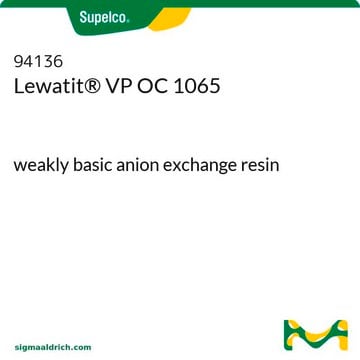13547
Diaion® CR11 sodium form
pkg of 1000 g
Iniciar sesiónpara Ver la Fijación de precios por contrato y de la organización
About This Item
Código UNSPSC:
23151817
Productos recomendados
descripción
weakly acidic cation exchange resin
formulario
beads
envase
pkg of 1000 g
Parámetros
120 °C Na+ form max. temp.
80 °C H+ form max. temp.
humedad
55-65%
técnicas
LPLC: suitable
matriz
crosslinked polystyrene (highly porous)
grupo activo de la matriz
iminodiacetic acid functional group
tamaño de partícula
16-45 mesh
pH operativo
4-10
capacidad
0.35 meq/mL by wetted bed volume (calcium)
1.2 meq/g by dry weight (calcium)
técnica de separación
affinity
Categorías relacionadas
Descripción general
Diaion CR11 is chelating resin with iminodiacetic acid groups. It is considered effective in the removal of chromium trivalent from aqueous solutions. This resin in the Na+ form at 50°C is seen to exhibit high sorption capacity.
Aplicación
Diaion CR11 was used to prepare phosphate buffer, required to measure rate constants of the reactions of hypochlorite with L-Arg and taurine by stopped-flow spectrophotometry.
Chelating resin for metal recovery, wastewater treatment, brine purification, etc.
Información legal
Diaion is a registered trademark of Mitsubishi Chemical Corp.
Código de clase de almacenamiento
11 - Combustible Solids
Clase de riesgo para el agua (WGK)
WGK 3
Punto de inflamabilidad (°F)
Not applicable
Punto de inflamabilidad (°C)
Not applicable
Equipo de protección personal
Eyeshields, Gloves, type N95 (US)
Choose from one of the most recent versions:
¿Ya tiene este producto?
Encuentre la documentación para los productos que ha comprado recientemente en la Biblioteca de documentos.
Sofia A Cavaco et al.
Journal of hazardous materials, 169(1-3), 516-523 (2009-05-02)
In this study two chelating resins containing iminodiacetic acid groups (Amberlite IRC 748 and Diaion CR 11) and a chelating resin based on sulfonic and diphosphonic acid groups (Diphonix) were investigated in order to separate Cr(III) from industrial effluents produced
C Zhang et al.
The Journal of biological chemistry, 276(29), 27159-27165 (2001-05-26)
The myeloperoxidase-derived oxidant hypochlorous acid (HOCl) is thought to contribute to endothelial dysfunction, but the mechanisms underlying this inhibitory effect are unknown. The present study tested the hypothesis that HOCl and L-arginine (L-Arg) react to form novel compounds that adversely
Sofia A Cavaco et al.
Journal of hazardous materials, 144(3), 634-638 (2007-03-06)
Effluent discharged from the chromium electroplating industry contains a large number of metals, including chromium, copper, nickel, zinc, manganese and lead. The ion exchange process is an alternative technique for application in the treatment of industrial wastewater containing heavy metals
Nuestro equipo de científicos tiene experiencia en todas las áreas de investigación: Ciencias de la vida, Ciencia de los materiales, Síntesis química, Cromatografía, Analítica y muchas otras.
Póngase en contacto con el Servicio técnico








